Material Erosion and Dust Formation during Tungsten Exposure to Hollow-Cathode and Microjet Discharges
Abstract
1. Introduction
2. Materials and Methods
2.1. Dedicated Experimental Setups for Plasma Generation
2.2. Methods of Surface Characterization and Materials Analysis
3. Experimental Results
3.1. Plasma-W Surface Interactions in the HC Configuration
Dust (Particles) Production in HC Configuration
3.2. Plasma-W Surface Interactions in the Case of Microjet Discharge
Dust Particles Production with MD Configuration
4. Chemical Analysis of Produced Dust
4.1. XPS Analysis of Dust (Particles) Obtained by HC Discharge
4.2. XPS Analysis of Dust (Particles) Obtained in MD Configuration
5. Conclusions
Author Contributions
Funding
Conflicts of Interest
References
- Bustreo, C.; Giuliani, U.; Maggio, D.; Zollino, G. How fusion power can contribute to a fully decarbonized European power mix after 2050. Fusion Eng. Des. 2019, 146, 2189–2193. [Google Scholar] [CrossRef]
- Grisolia, C.; Rosanvallon, S.; Sharpe, P.; Winter, J. Micro-particles in ITER: A comprehensive review. J. Nucl. Mater. 2009, 386–388, 871–873. [Google Scholar] [CrossRef]
- Rubel, M.; Widdowson, A.; Grzonka, J.; Fortuna-Zalesna, E.; Moon, S.; Petersson, P.; Ashikawa, N.; Asakura, N.; Hamaguchi, D.; Hatano, Y.; et al. Dust generation in tokamaks: Overview of beryllium and tungsten dust characterisation in JET with the ITER-like wall. Fusion Eng. Des. 2018, 136, 579–586. [Google Scholar] [CrossRef]
- Grisolia, C.; Hodille, E.; Chene, J.; Garcia-Argote, S.; Pieters, G.; El-Kharbachi, A.; Marchetti, L.; Martin, F.; Miserque, F.; Vrel, D.; et al. Tritium absorption and desorption in ITER relevant materials: Comparative study of tungsten dust and massive samples. J. Nucl. Mater. 2015, 463, 885–888. [Google Scholar] [CrossRef]
- El-Kharbachi, A.; Chene, J.; Garcia-Argote, S.; Marchetti, L.; Martin, F.; Miserque, F.; Vrel, D.; Redolfi, M.; Malard, V.; Grisolia, C.; et al. Tritium absorption/desorption in ITER-like tungsten particles. Int. J. Hydrogen Energy 2014, 39, 10525–10536. [Google Scholar] [CrossRef]
- Humphreys, D.A.; Ferron, J.R.; Hyatt, A.W.; la Haye, R.J.; Leuer, J.A.; Penaflor, B.G.; Walker, M.L.; Welander, A.S.; In, Y. DIII-D integrated plasma control solutions for ITER and next-generation tokamaks. Fusion Eng. Des. 2008, 83, 193–197. [Google Scholar] [CrossRef]
- Rowcliffe, A.F.; Garrison, L.M.; Yamamoto, Y.; Tan, L.; Katoh, Y. Materials challenges for the fusion nuclear science facility. Fusion Eng. Des. 2018, 135, 290–301. [Google Scholar] [CrossRef]
- Koutsospyros, A.; Braida, W.; Christodoulatos, C.; Dermatas, D.; Strigul, N. A review of tungsten: From environmental obscurity to scrutiny. J. Hazard. Mater. 2006, 136, 1–19. [Google Scholar] [CrossRef]
- Shah, V.; van Maris, M.P.F.H.L.; van Dommelen, J.A.W.; Geers, M.G.D. Experimental investigation of the microstructural changes of tungsten monoblocks exposed to pulsed high heat loads. Nucl. Mater. Energy 2020, 22, 100716. [Google Scholar] [CrossRef]
- Bannister, M.E.; Meyer, F.W.; Hijazi, H.; Unocic, K.A.; Garrison, L.M.; Parish, M.C. Surface morphologies of He-implanted tungsten. Nucl. Instrum. Methods Phys. Res. B 2016, 382, 76–81. [Google Scholar] [CrossRef]
- Sandoval, L.; Perez, D.; Uberuaga, B.P.; Voter, A.F. Formation of helium-bubble networks in tungsten. Acta Mater. 2018, 159, 46–50. [Google Scholar] [CrossRef]
- You, J.-H. Mechanics of tungsten blistering: A finite element study. J. Nucl. Mater. 2013, 437, 24–28. [Google Scholar] [CrossRef]
- Li, M.; You, J.-H. Mechanics of tungsten blistering II: Analytical treatment and fracture mechanical assessment. J. Nucl. Mater. 2015, 465, 702–709. [Google Scholar] [CrossRef]
- Butler, B.G.; Paramore, J.D.; Ligda, J.P.; Ren, C.; Fang, Z.Z.; Middlemas, S.; Hemker, K.J. Mechanisms of deformation and ductility in tungsten—A review. Int. J. Refract. Met. Hard. Mater. 2018, 75, 248–261. [Google Scholar] [CrossRef]
- Zhou, H.; Yu, J.; Chen, C.; Zhu, K. Effect of pre-damage induced by argon ions on the deuterium blister formation in tungsten-tantalum alloys exposed to deuterium plasma. Int. J. Hydrogen Energy 2019, 44, 23320–23329. [Google Scholar] [CrossRef]
- Dumitru, L.A.; Eftimie, S.; Mihailescu, M.I.; Nita, S.L.; Opris, V.; Racuciu, C. A novel architecture for authenticating scalable resources in hybrid cloud. In Proceedings of the 2016 International Conference on Communications (COMM), Bucharest, Romania, 9–10 June 2016; pp. 251–254. [Google Scholar] [CrossRef]
- Dascalescu, A.C.; Boriga, R.; Mihailescu, M.I. A novel chaos-based image encryption scheme. Ann. Univ. Craiova Math. Comput. Sci. Ser. 2014, 41, 47–58, ISSN 1223-6934. [Google Scholar]
- Nita, S.L.; Mihailescu, M.I.; Pau, V.C. Security and cryptographic challenges for authentication based on biometrics data. Cryptography 2018, 2, 39. [Google Scholar] [CrossRef]
- Mihailescu, M.I.; Racuciu, C.; Grecu, D.L.; Nita, S.L. A multi-factor authentication scheme including biometric characteristics as one factor. Mircea Batran Nav. Acad. Sci. Bull. 2015, 17, 348–353. [Google Scholar]
- Nita, S.L.; Mihailescu, M.I. On Artificial Neural Network used in Cloud Computing Security—A Survey. In Proceedings of the 2018 10th International Conference on Electronics, Computers and Artificial Intelligence (ECAI), Iasi, Romania, 28–30 June 2018; pp. 1–6. [Google Scholar] [CrossRef]
- Circei, C.; Stoica, C.; Mihailescu, M.I.; Racuciu, C. A new modeling perspective on vocal tract. Mircea Batran Nav. Acad. Sci. Bull. 2016, 19, 354–358. [Google Scholar] [CrossRef]
- Nita, S.L.; Mihailescu, M.I. A hybrid searchable encryption scheme for cloud computing. In Innovative Security Solutions for Information Technology and Communications, Proceedings of the SECITC 2018; Lecture Notes in Computer Science; Lanet, J.L., Toma, C., Eds.; Springer: Cham, Switzerland, 2019; Volume 11359. [Google Scholar] [CrossRef]
- Wirth, B.D.; Hammond, K.D.; Krasheninnikov, S.; Maroudas, D. Challenges and opportunities of modeling plasma–surface interactions in tungsten using high-performance computing. J. Nucl. Mater. 2015, 463, 30–38. [Google Scholar] [CrossRef]
- Parsi, M.; Jatale, A.; Agrawal, M.; Sharma, P. Effect of surface deformation on erosion prediction. Wear 2019, 430–431, 57–66. [Google Scholar] [CrossRef]
- Cusentino, M.A.; Hammond, K.D.; Sefta, F.; Juslin, N.; Wirth, B.D. A comparison of interatomic potentials for modeling tungsten–hydrogen–helium plasma–surface interaction. J. Nucl. Mater. 2015, 463, 347–350. [Google Scholar] [CrossRef]
- Ito, A.M.; Takayama, A.; Oda, Y.; Tamura, T.; Kobayashi, R.; Hattori, T.; Ogata, S.; Ohno, N.; Kajita, S.; Yajima, M.; et al. Molecular dynamics and Monte Carlo hybrid simulation for fuzzy tungsten nanostructure formation. Nucl. Fusion 2015, 55, 073013. [Google Scholar] [CrossRef]
- Ito, A.M.; Yoshimoto, Y.; Saito, S.; Takayama, A.; Nakamura, H. Molecular dynamics simulation of a helium bubble bursting on tungsten surfaces. Phys. Scr. 2014, T159, 014062. [Google Scholar] [CrossRef]
- Ito, A.M.; Yoshimoto, Y.; Saito, S.; Takayama, A.; Nakamura, H. Formation of helium induced nanostructure ‘fuzz’ on various tungsten grades. J. Nucl. Mater. 2010, 404, 165–173. [Google Scholar] [CrossRef]
- Mayer, M.; Lederer, S. Influence of tungsten fuzz on energy spectra of helium recoiled by 10 MeV oxygen ions. Nucl. Interact. Methods Phys. Res. B 2019, 453, 67–74. [Google Scholar] [CrossRef]
- Evans, T.E. ELM mitigation techniques. J. Nucl. Mater. 2013, 438, S11–S18. [Google Scholar] [CrossRef]
- Coenen, J.W.; Arnoux, G.; Bazylev, B.; Matthews, G.; Jachmich, S.; Balboa, I.; Clever, M.; Dejarnac, R.; Coffey, I.; Corre, Y.; et al. ELM induced tungsten melting and its impact on tokamak operation. J. Nucl. Mater. 2015, 463, 78–84. [Google Scholar] [CrossRef]
- Solano, E.R.; Jachmich, S.; Villone, F.; Hawkes, N.; Corre, Y.; Pitts, R.; Loarte, A.; Alper, B.; Guenther, K.; Koroktov, A.; et al. ELMs and strike point jumps. J. Nucl. Mater. 2005, 337–339, 747–750. [Google Scholar] [CrossRef]
- Gauthier, E.; Andrew, P.; Arnoux, G.; Corre, Y.; Roche, H.; JET-EFDA Contributors. Plasma wall interaction during ELMs in JET. J. Nucl. Mater. 2007, 363–365, 1026–1031. [Google Scholar] [CrossRef]
- Samaddar, D.; Coster, D.P.; Bonnin, X.; Berry, L.A.; Elwasif, W.R.; Batchelor, D.B. Application of the parareal algorithm to simulations of ELMs in ITER plasma. Comput. Phys. Commun. 2019, 235, 246–257. [Google Scholar] [CrossRef]
- Heinola, K.; Ahlgren, T.; Brezinsek, S.; Vuoriheimo, T.; Wiesen, S.; JET Contributors. Modelling of the effect of ELMs on fuel retention at the bulk W divertor of JET. Nucl. Mater. Energy 2019, 19, 397–402. [Google Scholar] [CrossRef]
- Pestchanyi, S.; Garkusha, I.; Landman, I. Simulation of tungsten armour cracking due to small ELMs in ITER. Fusion Eng. Des. 2010, 85, 1697–1701. [Google Scholar] [CrossRef]
- Sinclair, G.; Gonderman, S.; Tripathi, J.K.; Hassanein, A. Effect of ELM pacing on morphology evolution and erosion of tungsten as a plasma-facing material in a fusion environment. J. Nucl. Mater. 2018, 508, 26–32. [Google Scholar] [CrossRef]
- Lunsford, R.; Bortolon, A.; Maingi, R.; Mansfield, D.K.; Nagy, A.; Jackson, G.L.; Osborne, T. Supplemental ELM control in ITER through beryllium granule injection. Nucl. Mater. Energy 2019, 19, 34–41. [Google Scholar] [CrossRef]
- Lemahieu, N.; Balden, M.; Elgeti, S.; Greuner, H.; Linke, J.; Maier, H.; Pintsuk, G.; Wirtz, M.; Van Oost, G.; Noterdaeme, J.-M. H/He irradiation on tungsten exposed to ELM-like thermal shocks. Fusion Eng. Des. 2016, 109–111, 169–174. [Google Scholar] [CrossRef]
- Knolker, M.; Evans, T.E.; Wingen, A.; Bortolon, A.; Chrystal, C.; Laggner, F.; Moyer, R.A.; Nazikian, R.; Zohm, H. Observation of divertor currents during type-I ELMs on the DIII-D tokamak. Nucl. Mater. Energy 2019, 18, 222–226. [Google Scholar] [CrossRef]
- Spolaore, M.; Kovarik, K.; Stockel, J.; Adamek, J.; Dejarnac, R.; Ďuran, I.; Komm, M.; Markovič, T.; Martines, E.; Panek, R.; et al. Electromagnetic ELM and inter-ELM filaments detected in the COMPASS Scrape-Off Layer. Nucl. Mater. Energy 2017, 12, 844–851. [Google Scholar] [CrossRef]
- Diez, M.; Firdaouss, M.; Richou, M.; Bultel, A.; Perry, F.; Roche, H.; Grisolia, C.; Missirlian, M. Tungsten coatings repair: An approach to increase the lifetime of plasma facing components. Fusion Eng. Des. 2019, 146, 800–804. [Google Scholar] [CrossRef]
- Brezinsek, S.; Coenen, J.W.; Schwarz-Selinger, T.; Schmid, K.; Kirschner, A.; Hakola, A.; Tabares, F.L.; van der Meiden, H.J.; Mayoral, M.-L.; Reinhart, M.; et al. Plasma–wall interaction studies within the EUROfusion consortium: Progress on plasma-facing components development and qualification. Nucl. Fusion 2017, 57, 116041. [Google Scholar] [CrossRef]
- Ueda, Y.; Miyata, K.; Ohtsuka, Y.; Lee, H.T.; Fukumoto, M.; Brezinsek, S.; Coenen, J.W.; Kreter, A.; Litnovsky, A.; Philipps, V.; et al. Exposure of tungsten nano-structure to TEXTOR edge plasma. J. Nucl. Mater. 2011, 415, S92–S95. [Google Scholar] [CrossRef]
- El-Atwani, O.; Gonderman, S.; Efe, M.; De Temmerman, G.; Morgan, T.; Bystrov, K.; Klenosky, D.; Qiu, T.; Allain, J.P. Ultrafine tungsten as a plasma-facing component in fusion devices: Effect of high flux, high fluence low energy helium irradiation. Nucl. Fusion 2014, 54, 083013. [Google Scholar] [CrossRef]
- Wirtz, M.; Berger, M.; Huber, A.; Kreter, A.; Linke, J.; Pintsuk, G.; Rasinski, M.; Sergienko, G.; Unterberg, B. Influence of helium induced nanostructures on the thermal shock performance of tungsten. Nucl. Mater. Energy 2016, 9, 177–180. [Google Scholar] [CrossRef]
- Stancu, C.; Stokker-Cheregi, F.; Moldovan, A.; Dinescu, M.; Grisolia, C.; Dinescu, G. Modification of W surfaces by exposure to hollow cathode plasmas. Appl. Phys. A 2017, 123, 618. [Google Scholar] [CrossRef]
- Stokker-Cheregi, F.; Acsente, T.; Enculescu, I.; Grisolia, C.; Dinescu, G. Tungsten and Aluminium nanoparticles synthesized by laser and ablation in liquids. Dig. J. Nanomater. Biostruct. 2012, 7, 1569–1576. [Google Scholar]
- Acsente, T.; Negrea, R.F.; Nistor, L.C.; Matei, E.; Grisolia, C.; Birjega, R.; Dinescu, G. Tungsten nanoparticles with controlled shape and crystallinity obtained by magnetron sputtering and gas aggregation. Mater. Lett. 2017, 200, 121–124. [Google Scholar] [CrossRef]
- Marascu, V.; Lazea-Stoyanova, A.; Bonciu, A.; Satulu, V.; Dinescu, G. Tungsten particles fabrication by a microjet discharge. Mater. Res. Express 2020, 7, 066509. [Google Scholar] [CrossRef]
- Marascu, V.; Lazea-Stoyanova, A.; Stancu, C.; Dinescu, G. The influence of plasma operation parameters on synthesis process of copper particles at atmospheric pressure. Plasma Process. Polym. 2018, 15, 1700091. [Google Scholar] [CrossRef]
- Teodorescu, M.; Bazavan, M.; Ionita, E.R.; Dinescu, G. Characterization of an argon radiofrequency plasma jet discharge continuously passing from low to atmospheric pressure. Plasma Sources Sci. Technol. 2012, 21, 055010. [Google Scholar] [CrossRef]
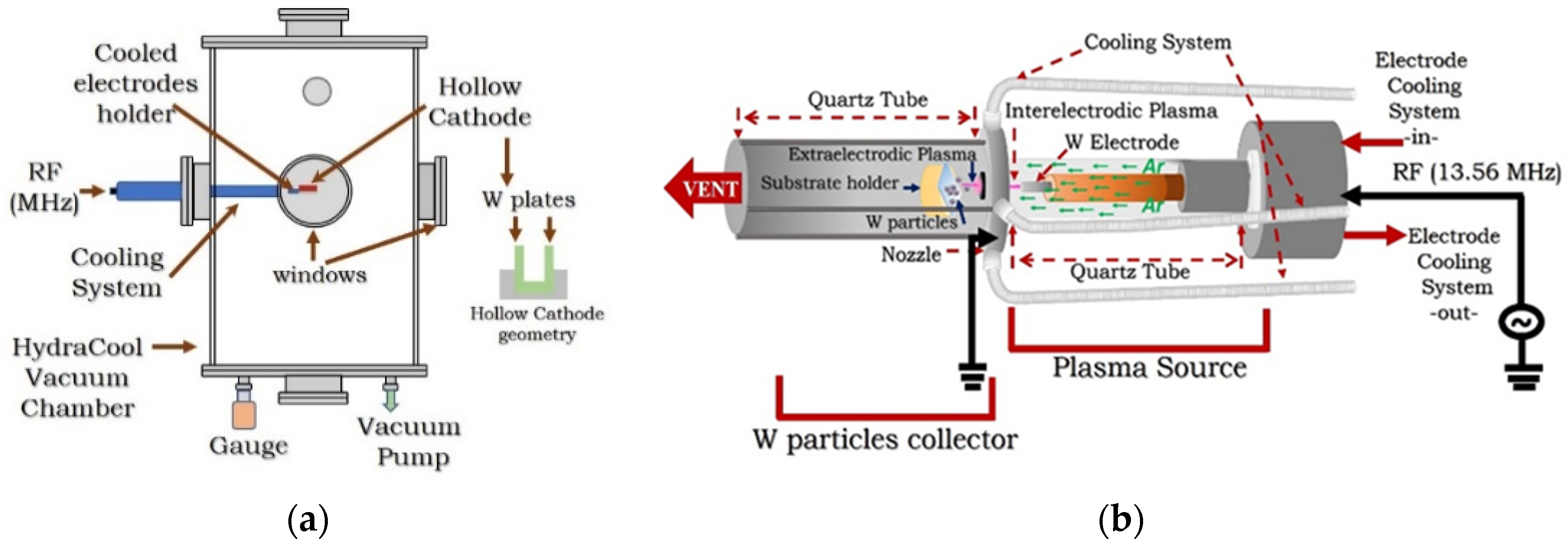
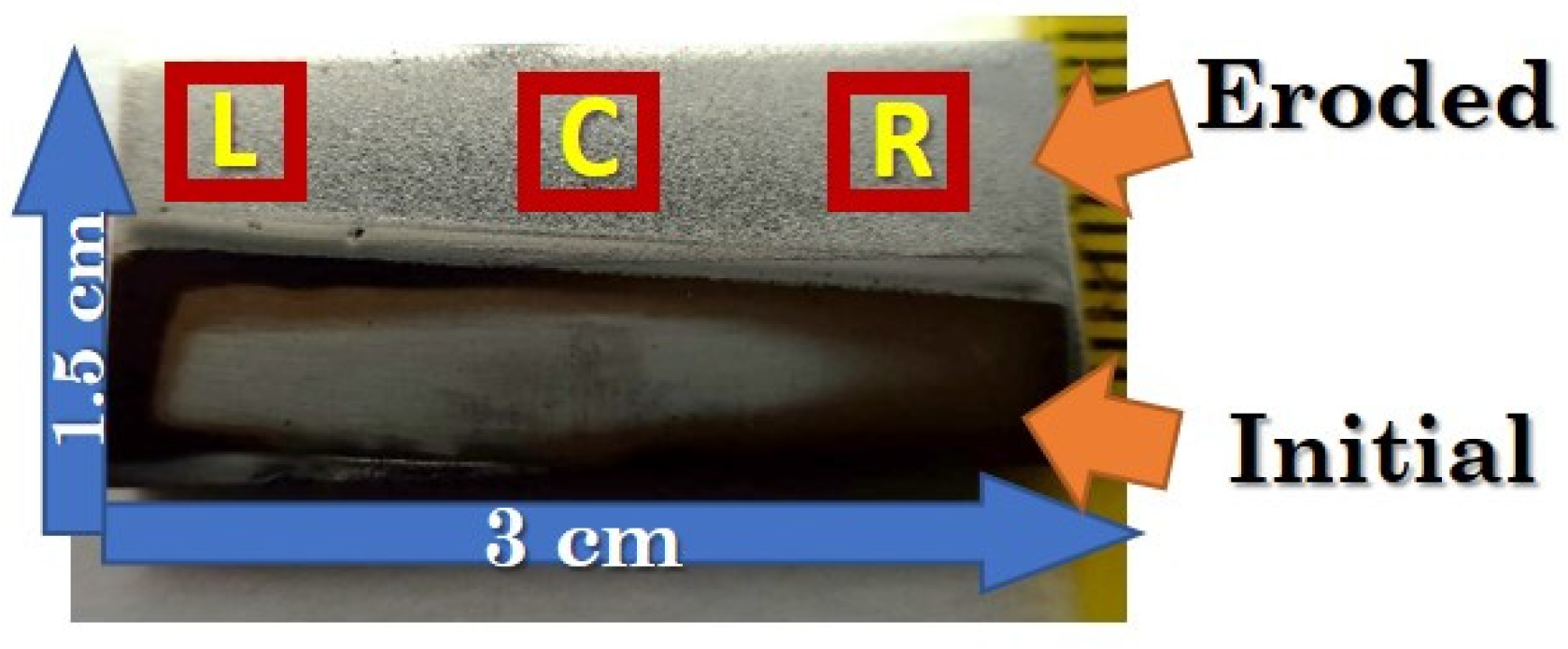
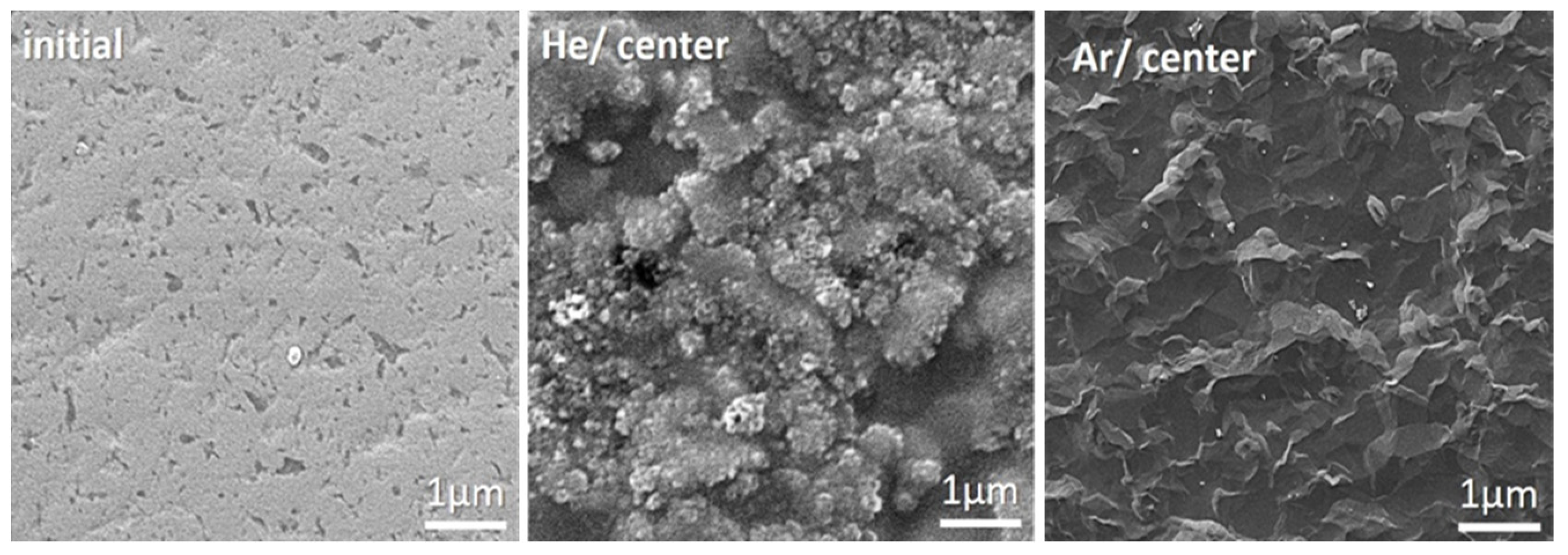
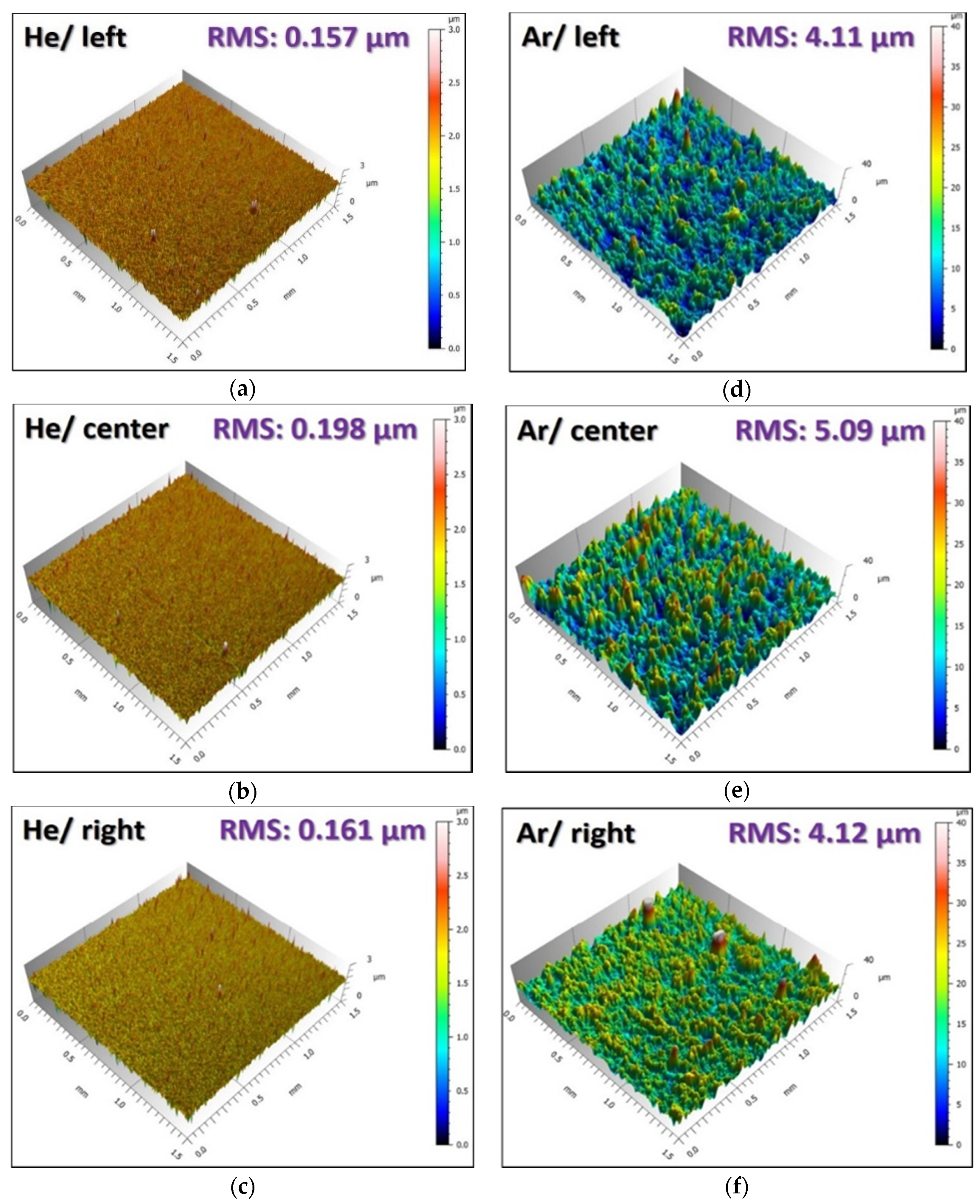
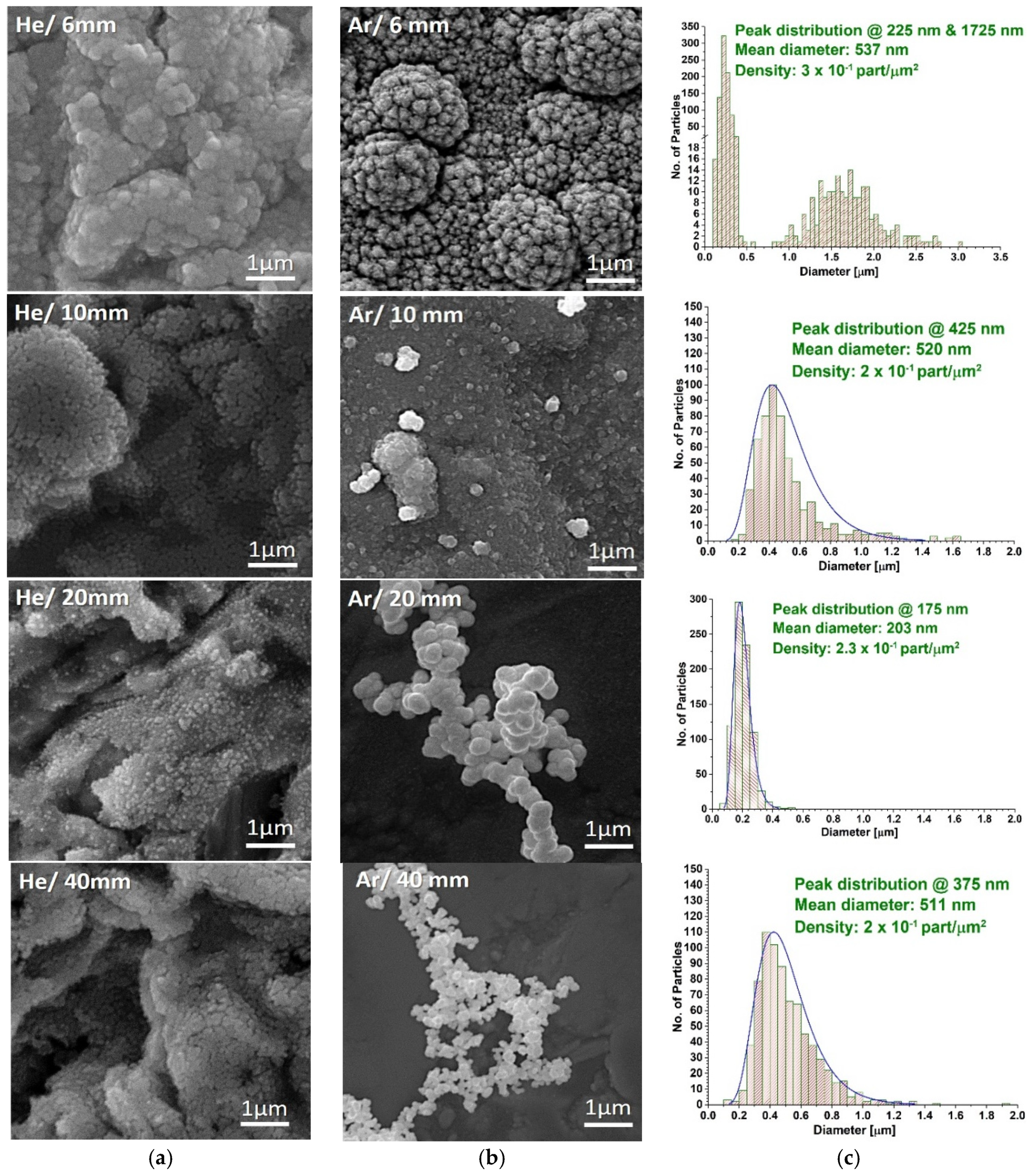
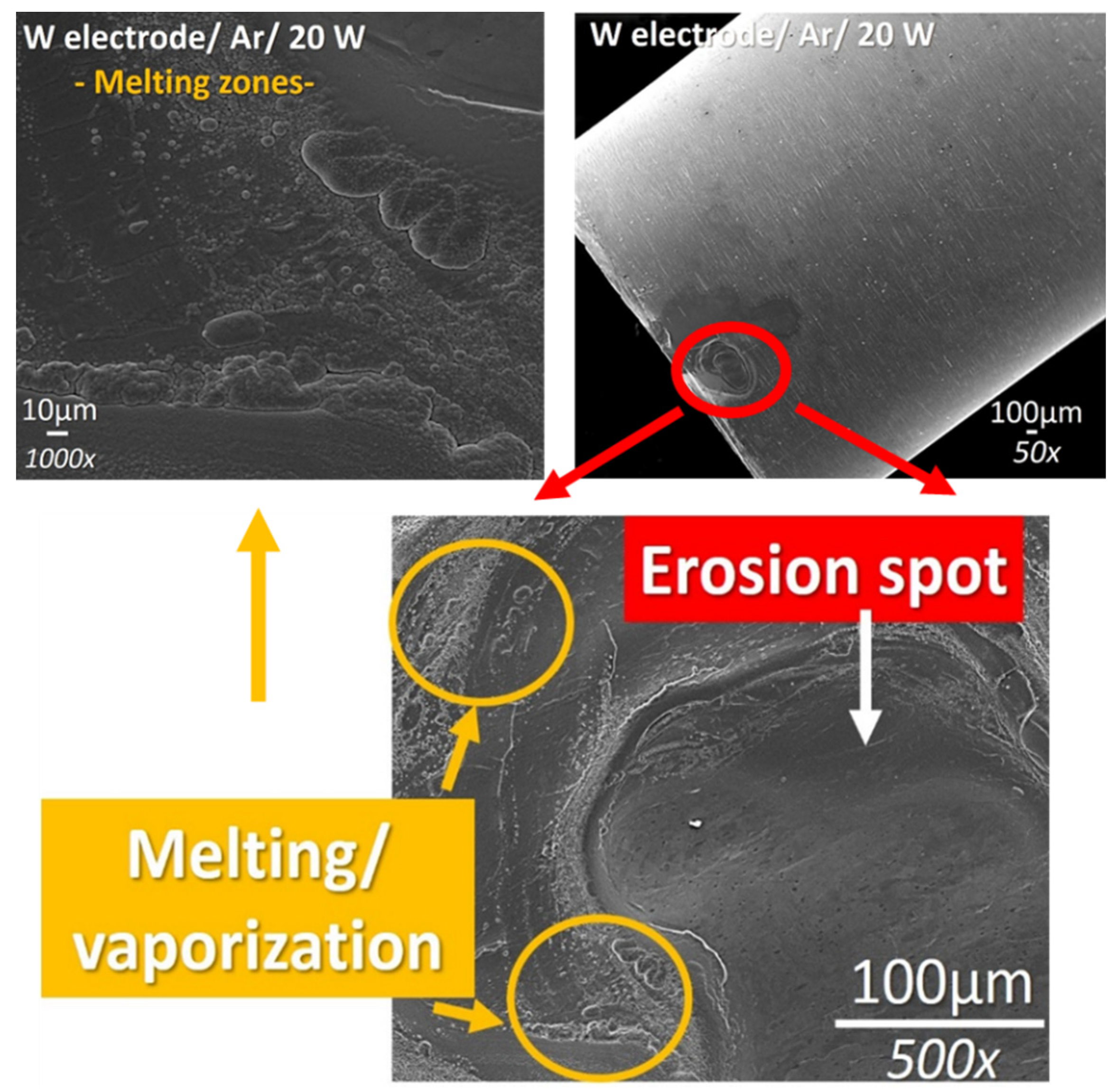
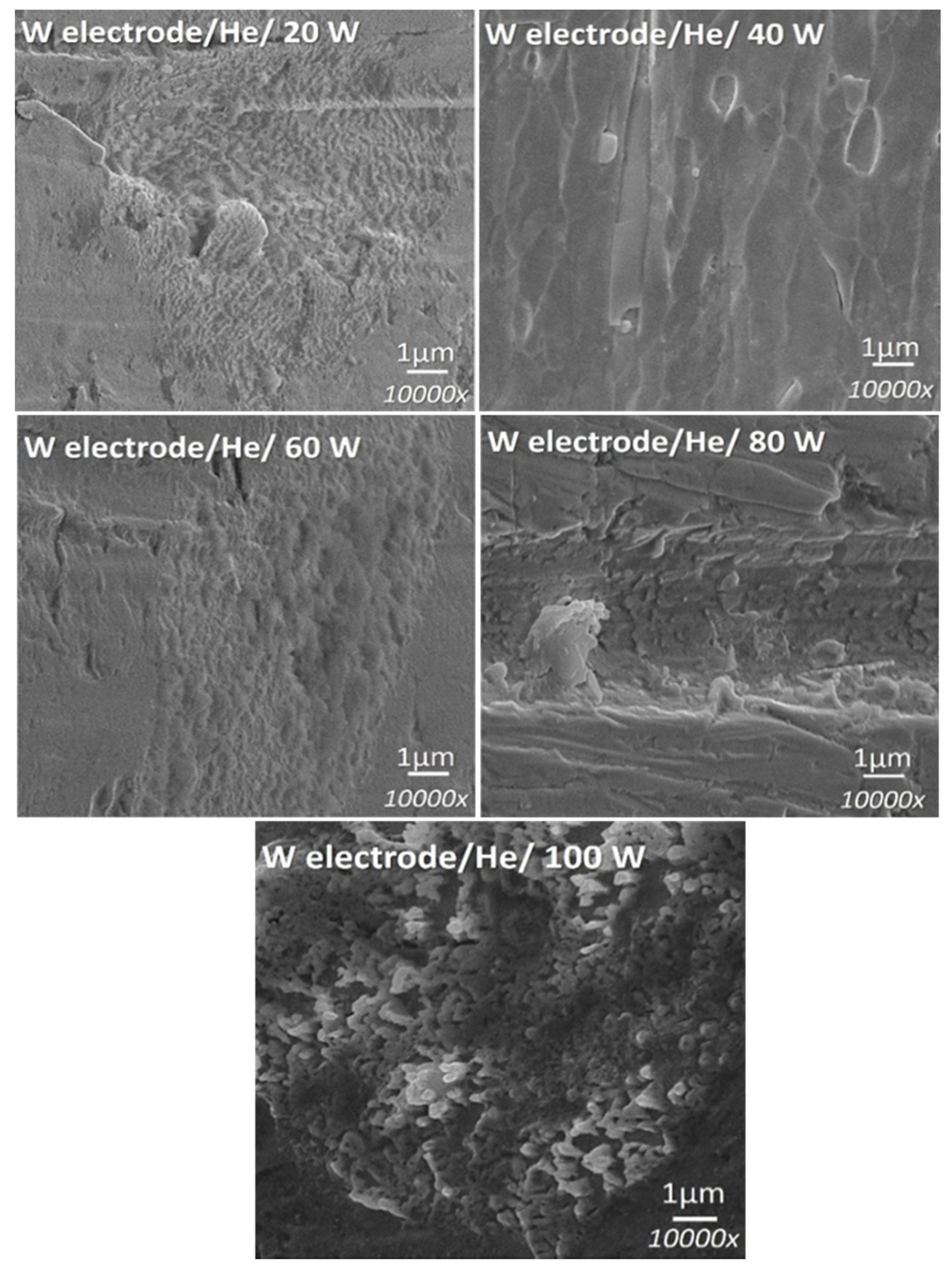
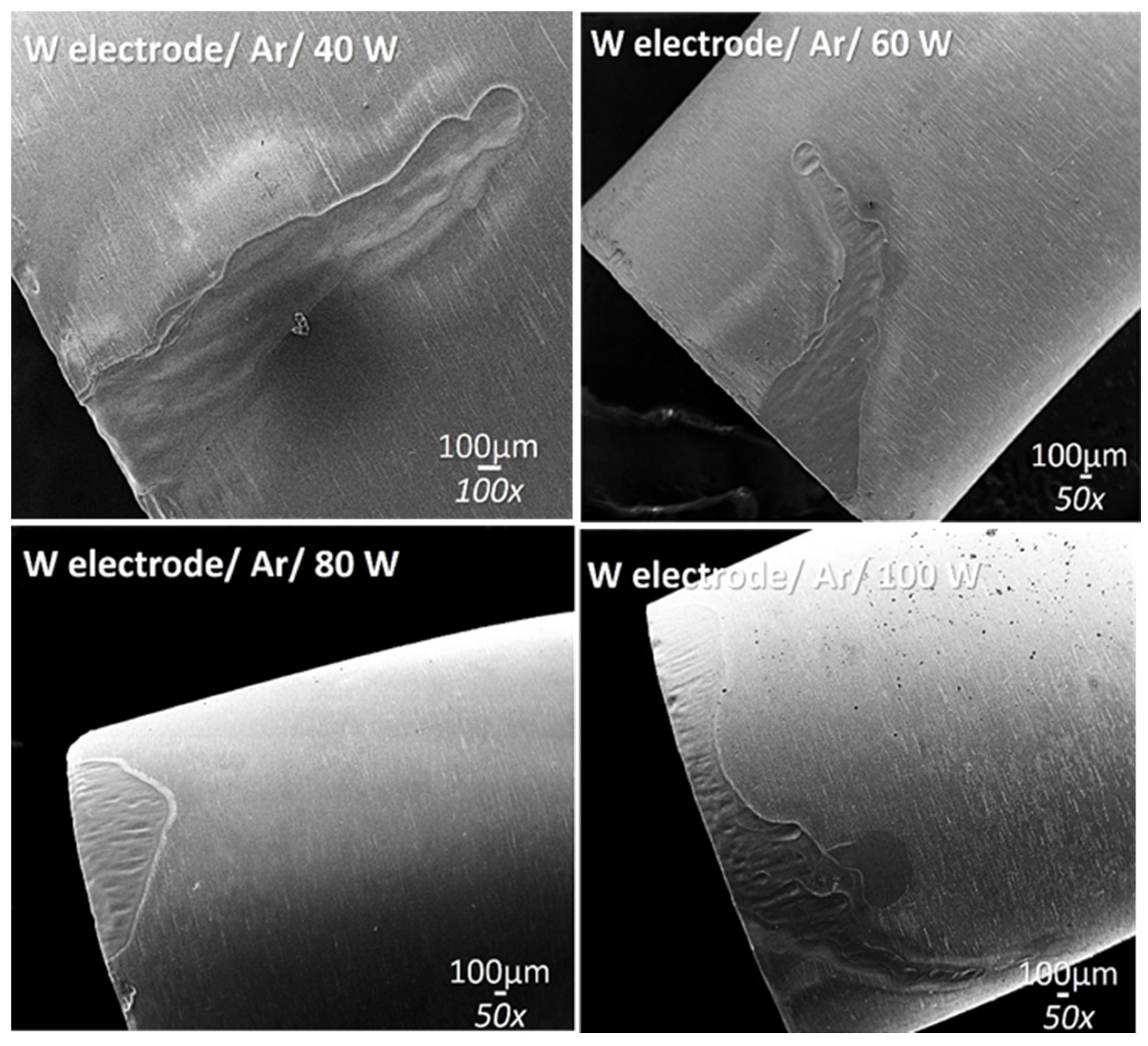
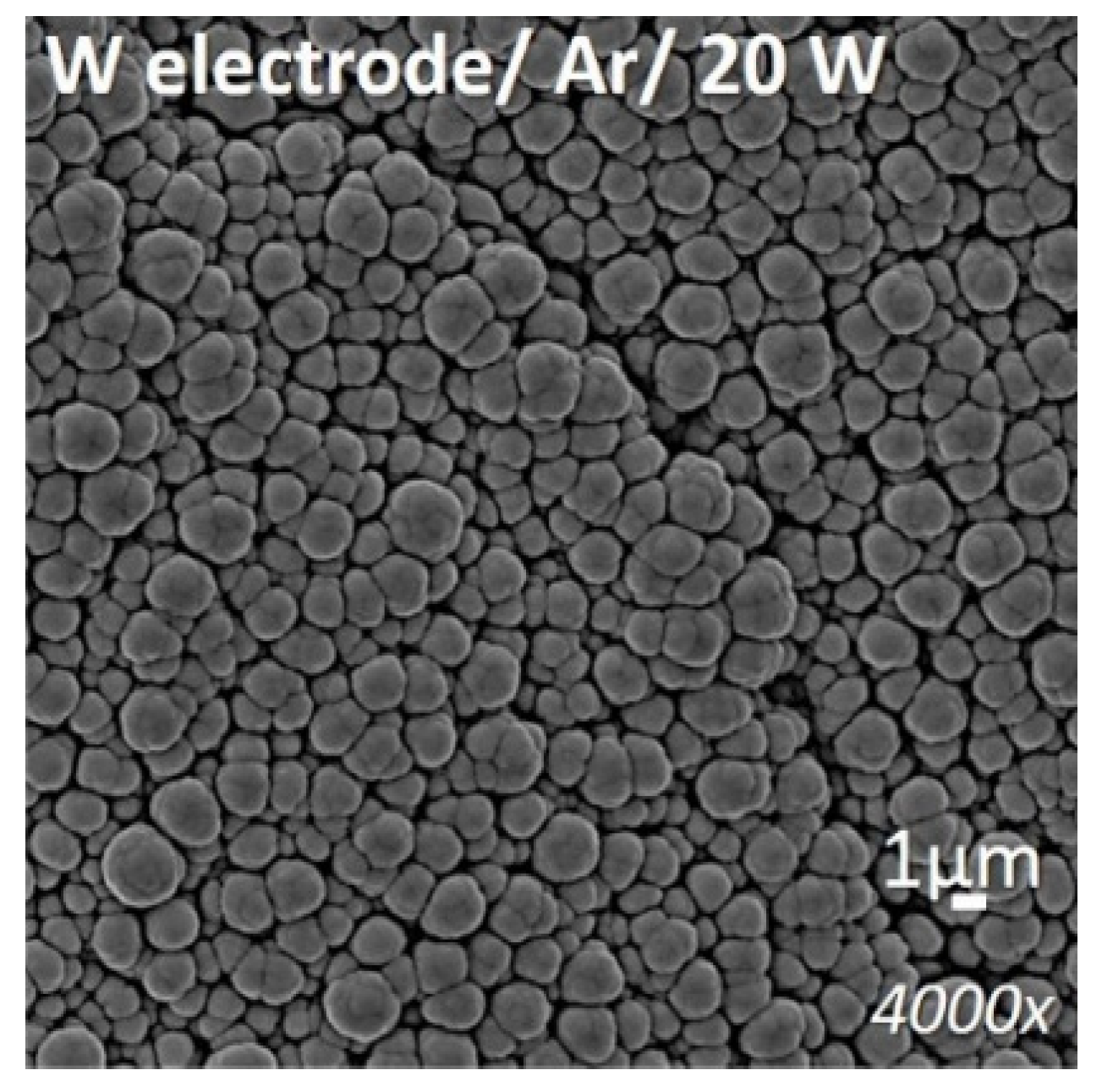
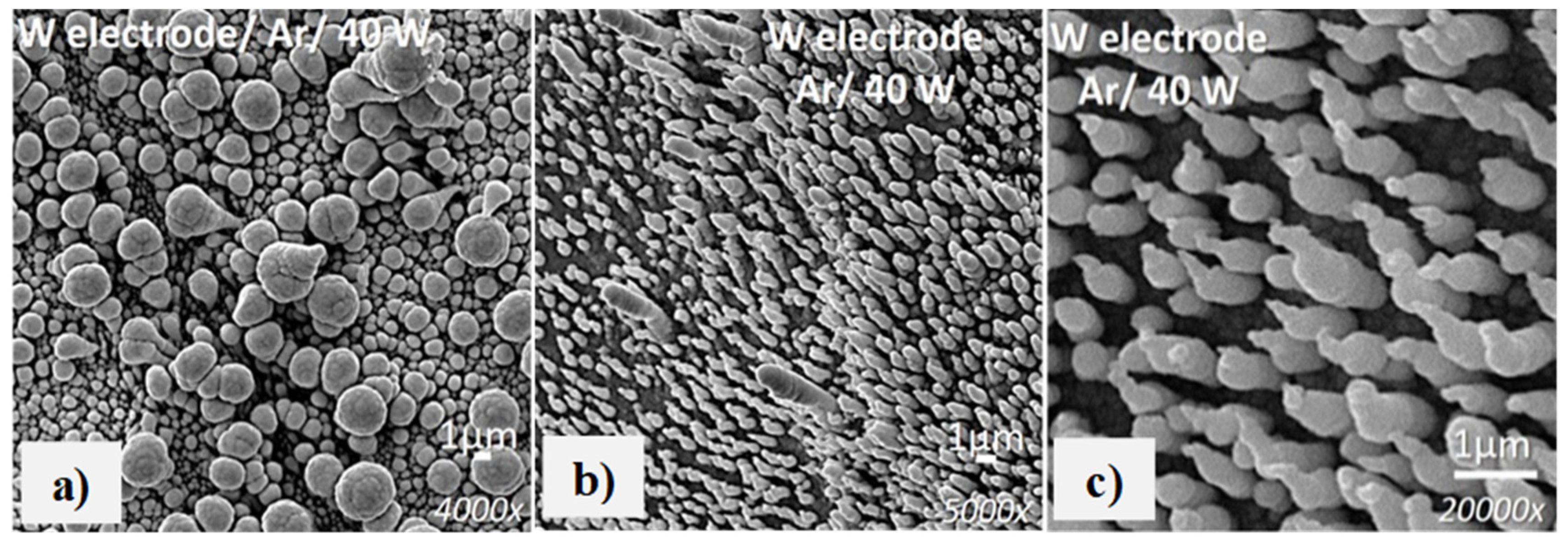
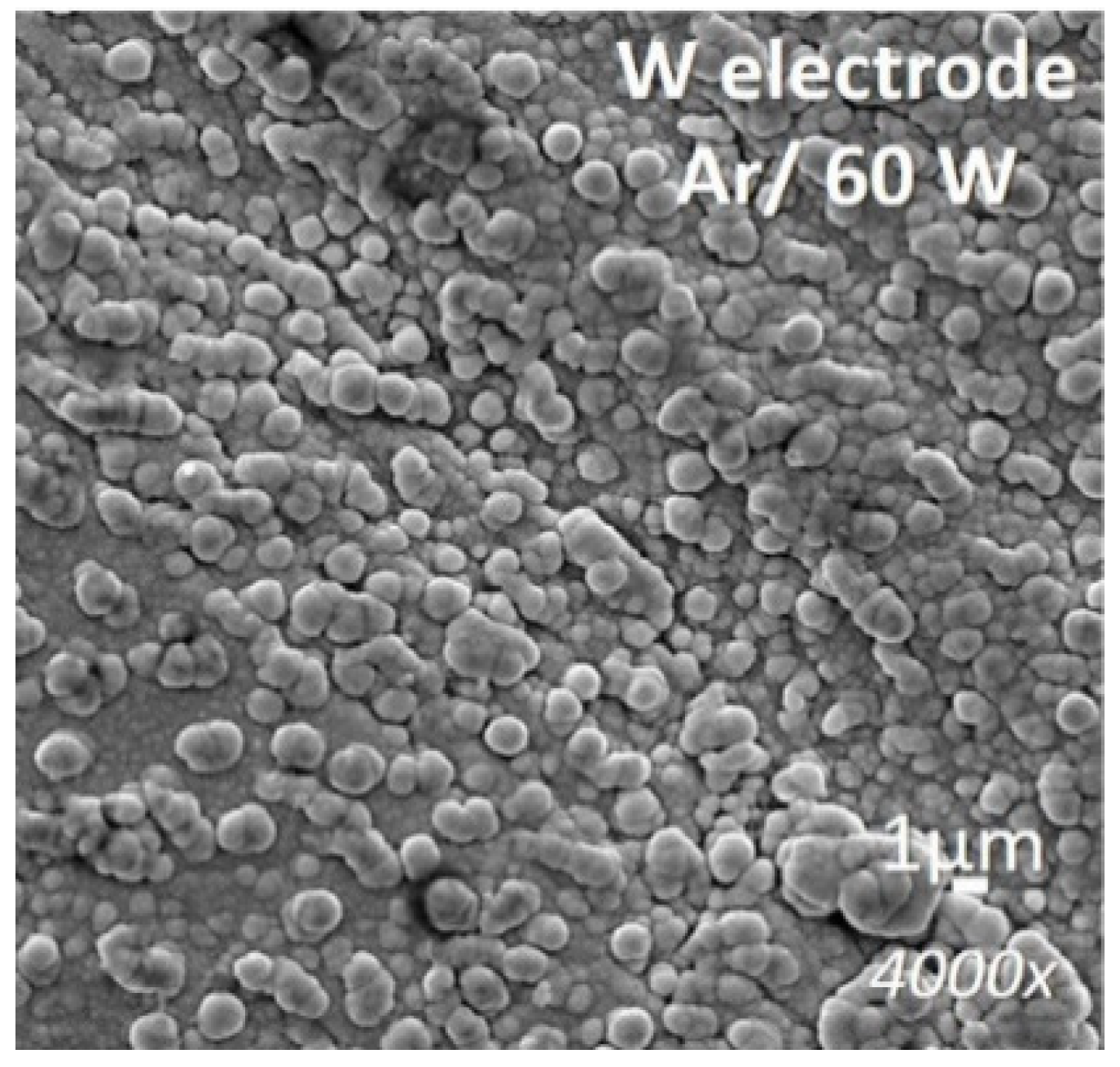
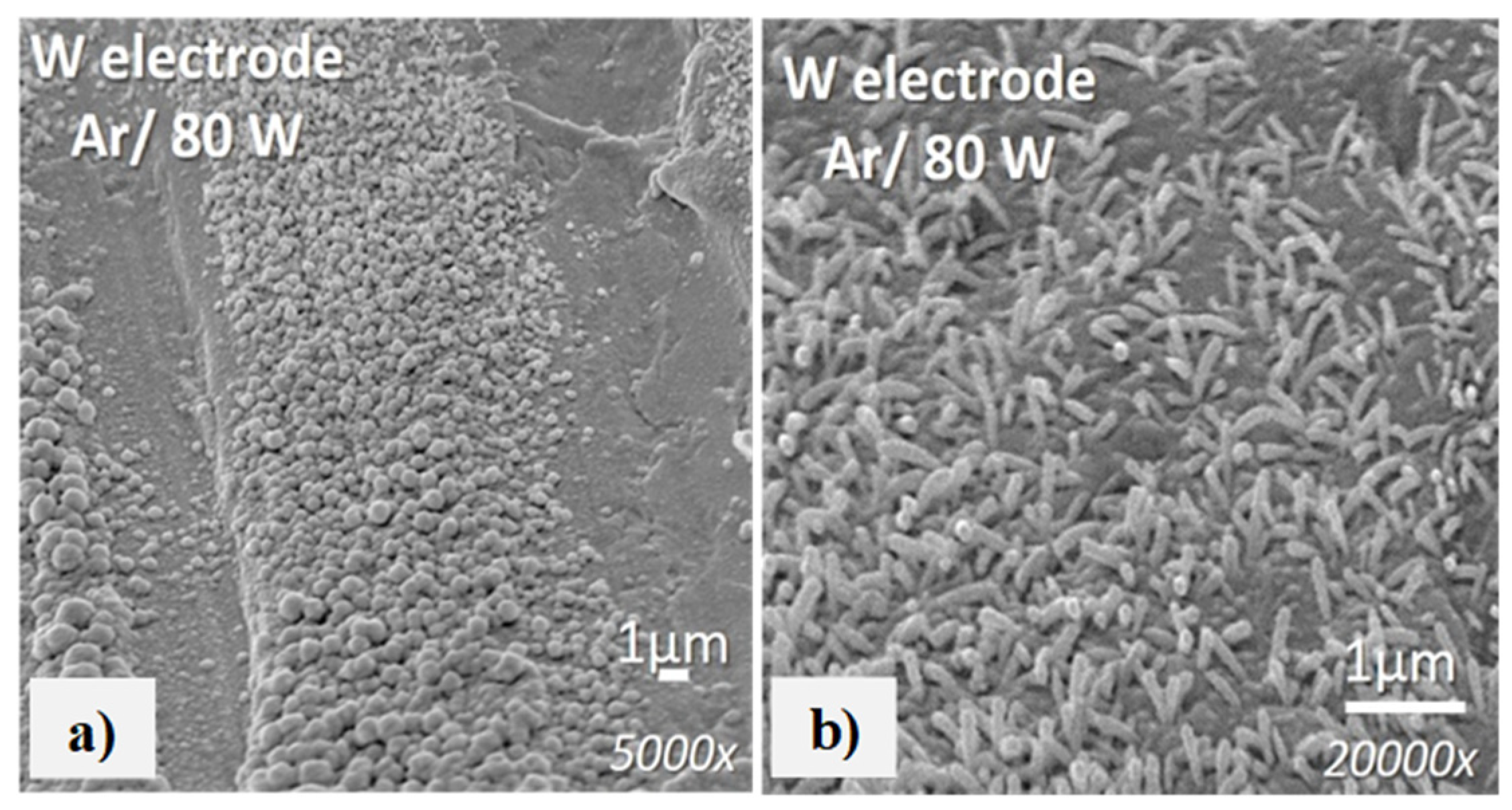
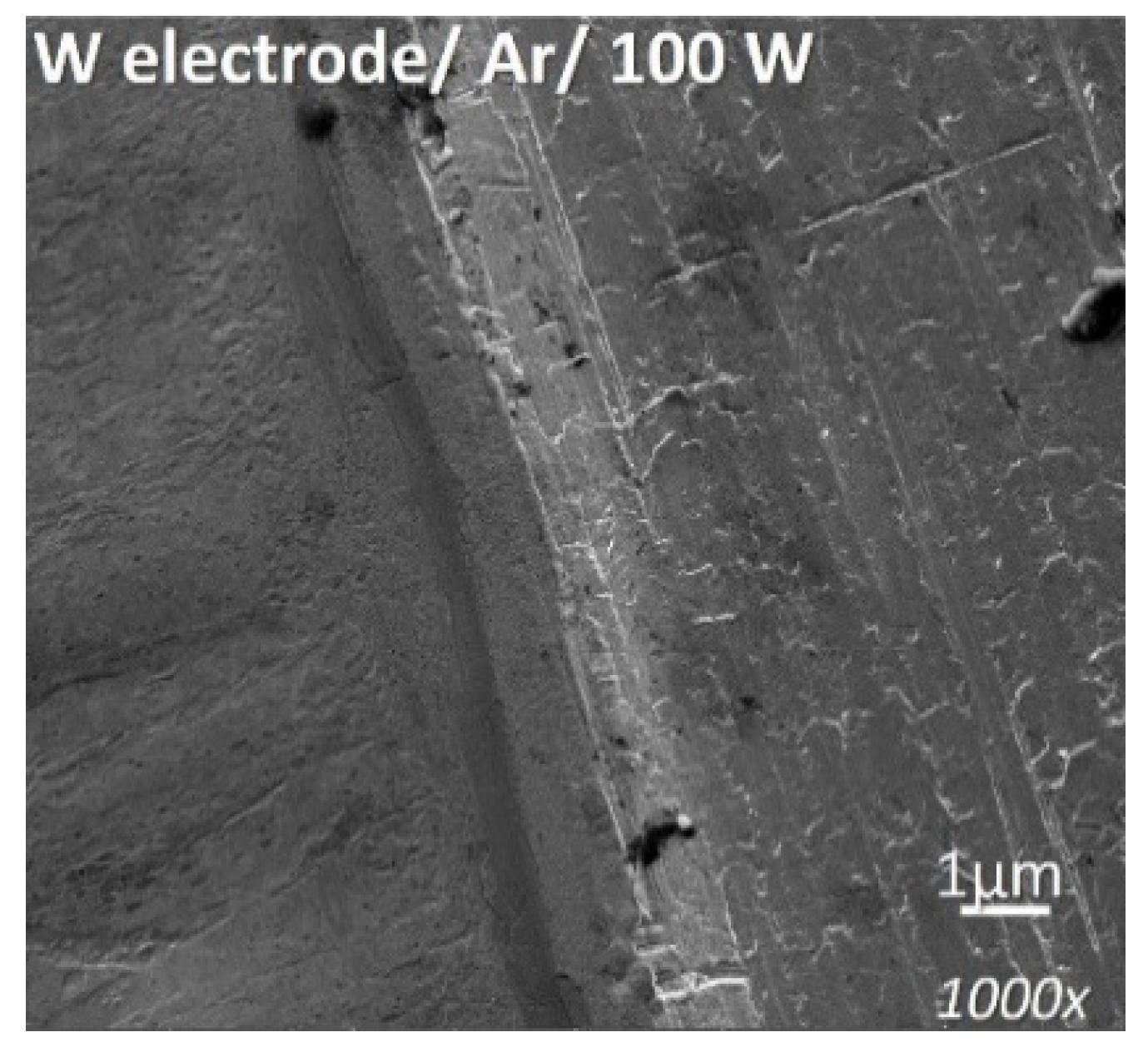
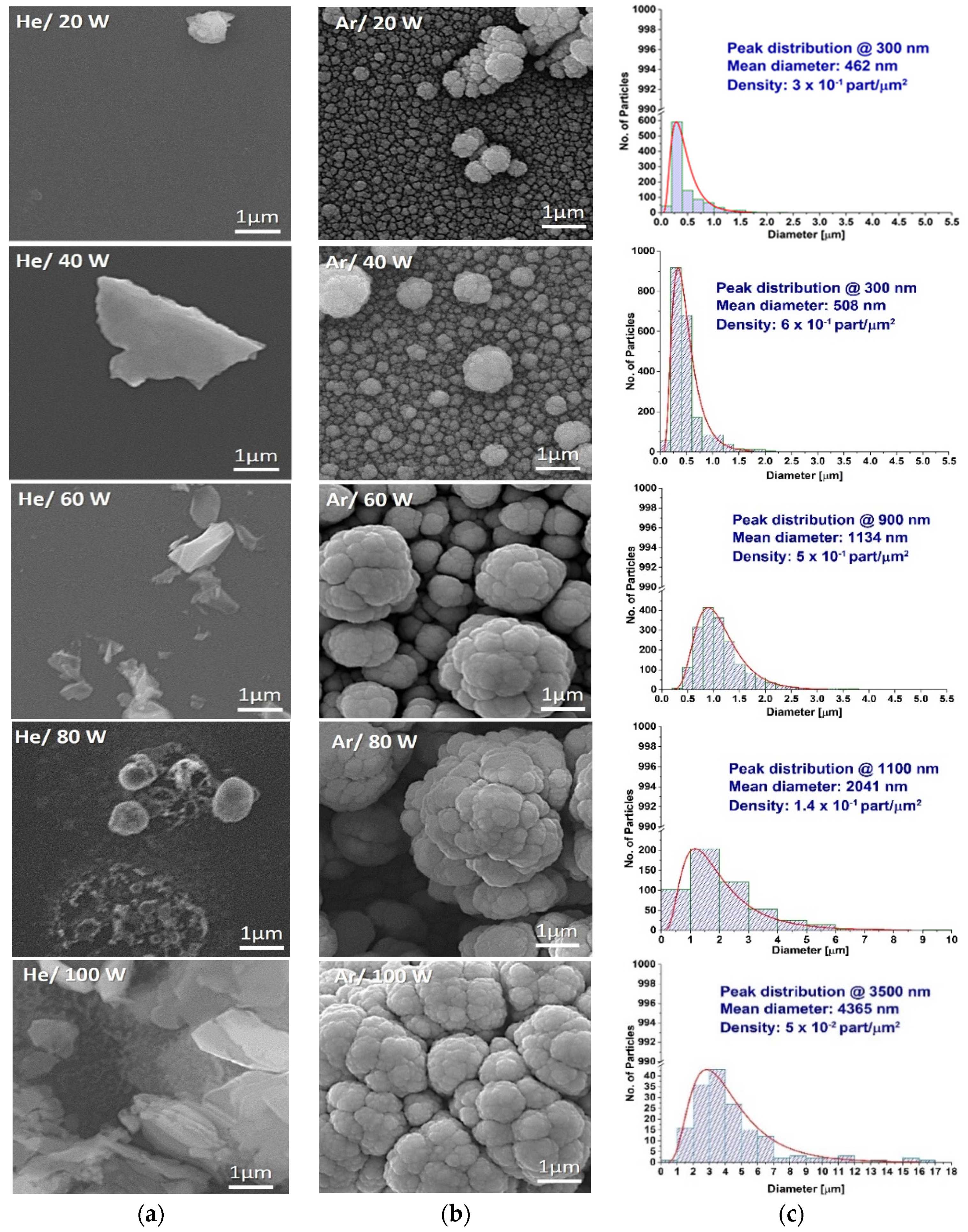
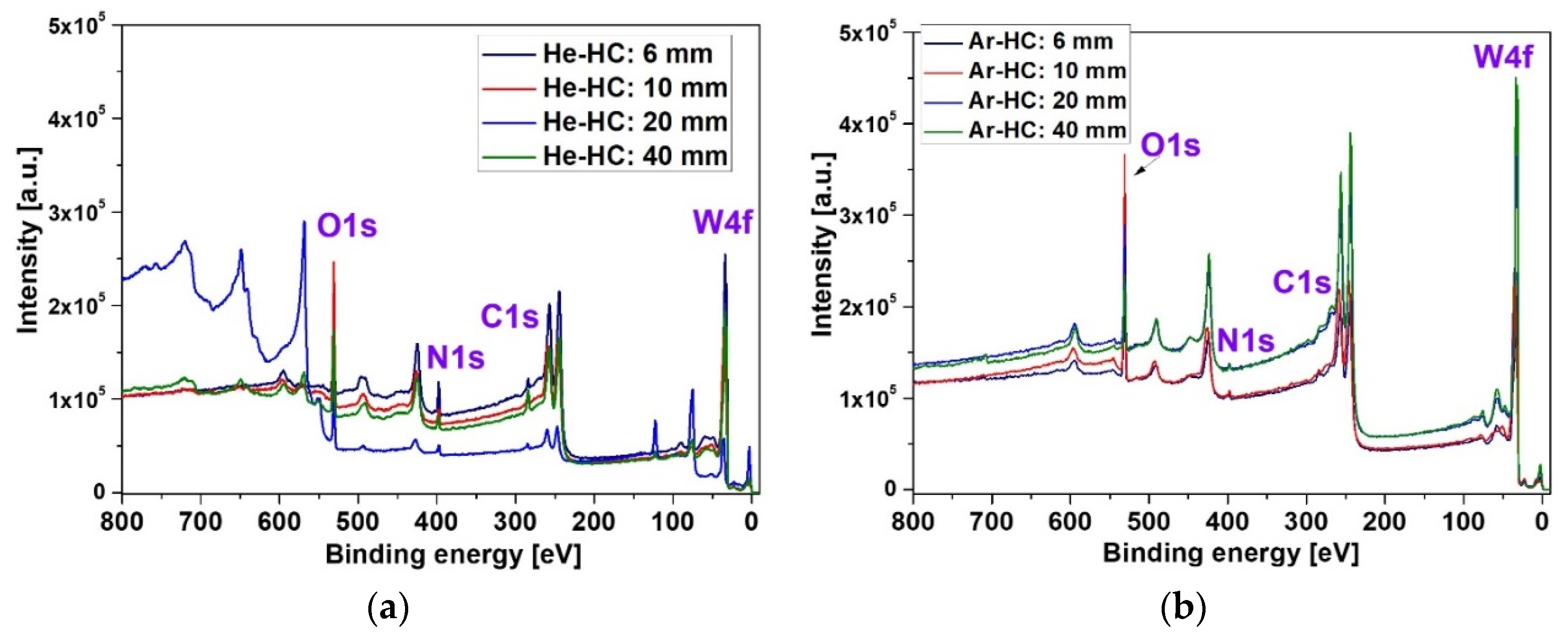
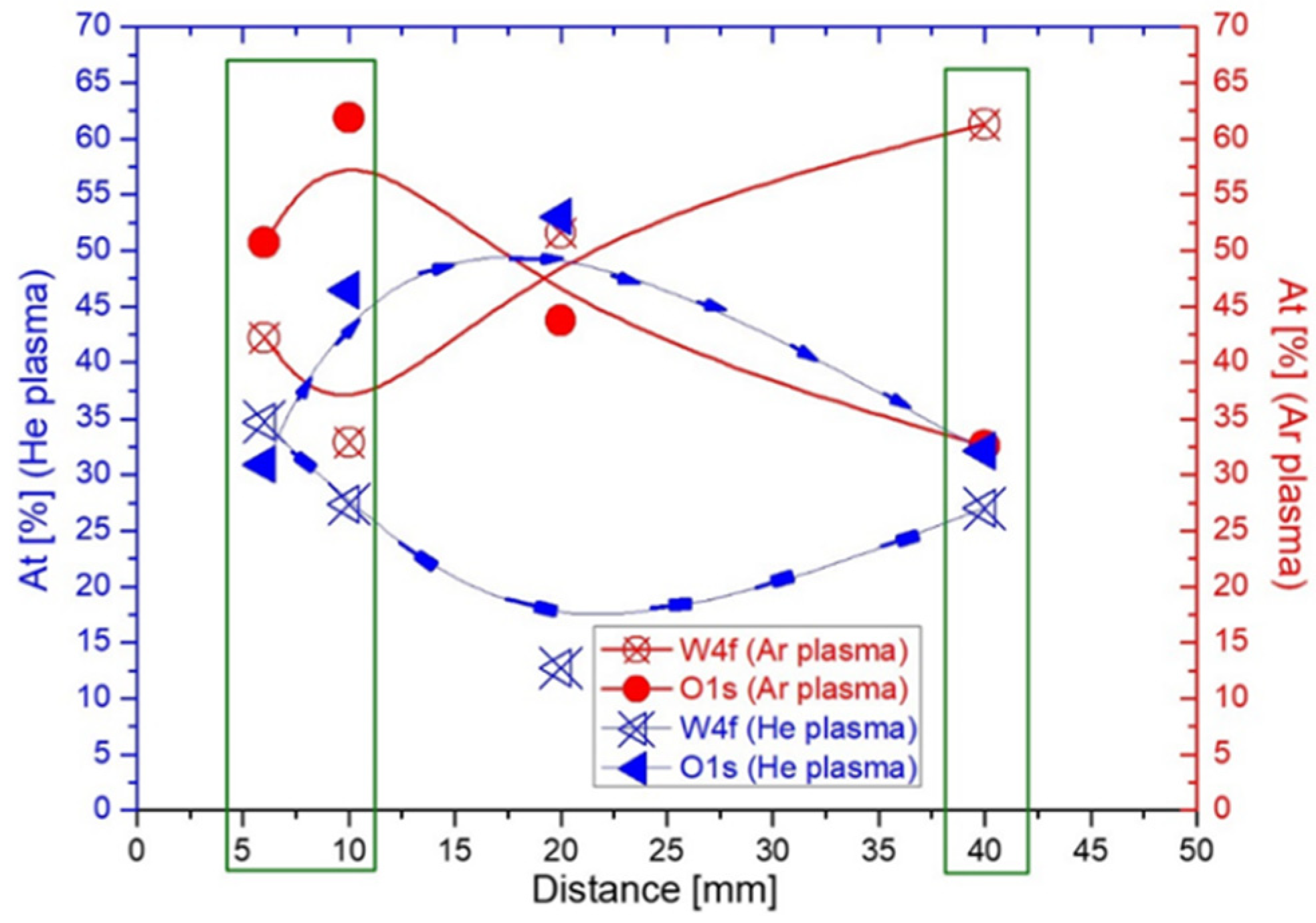
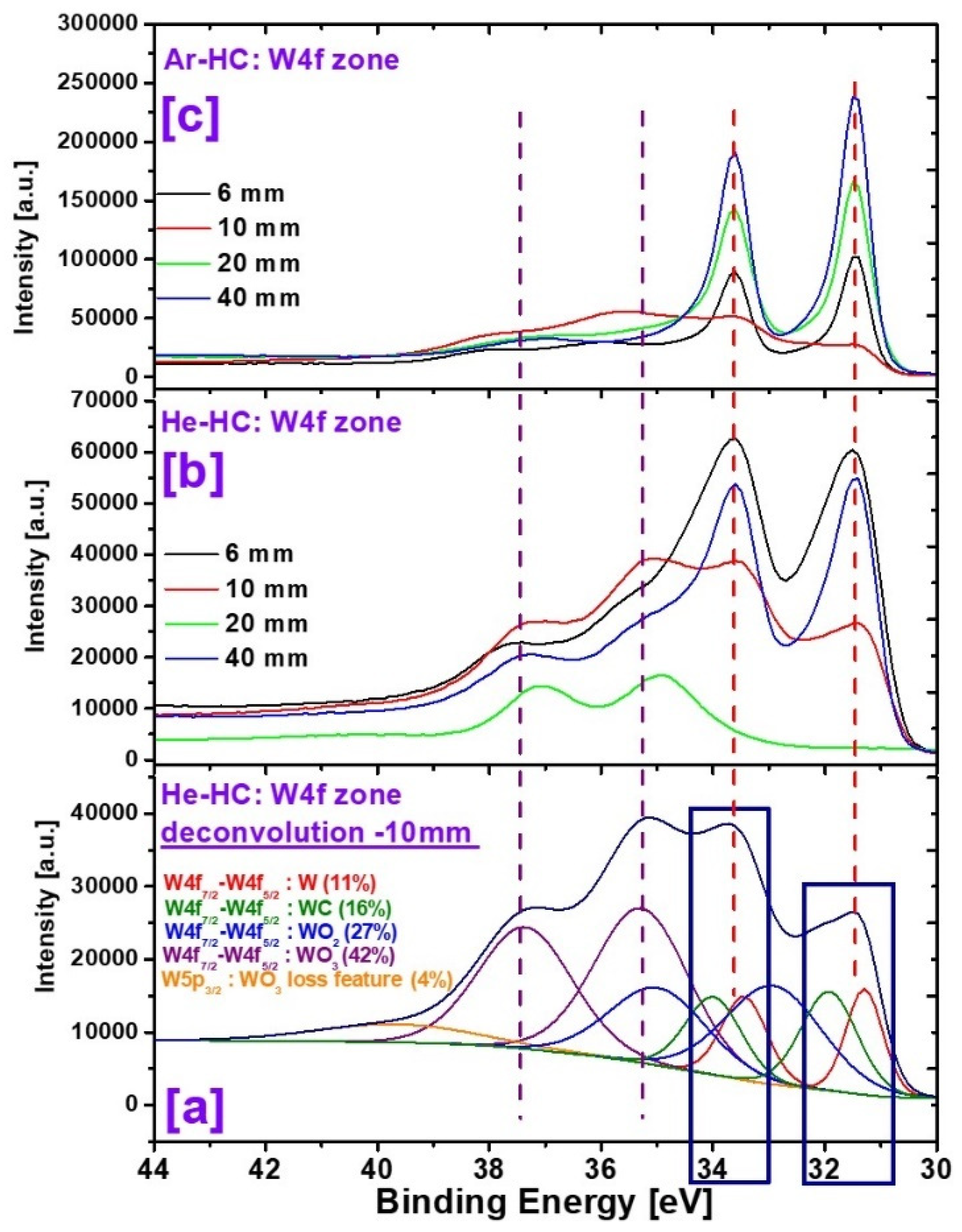
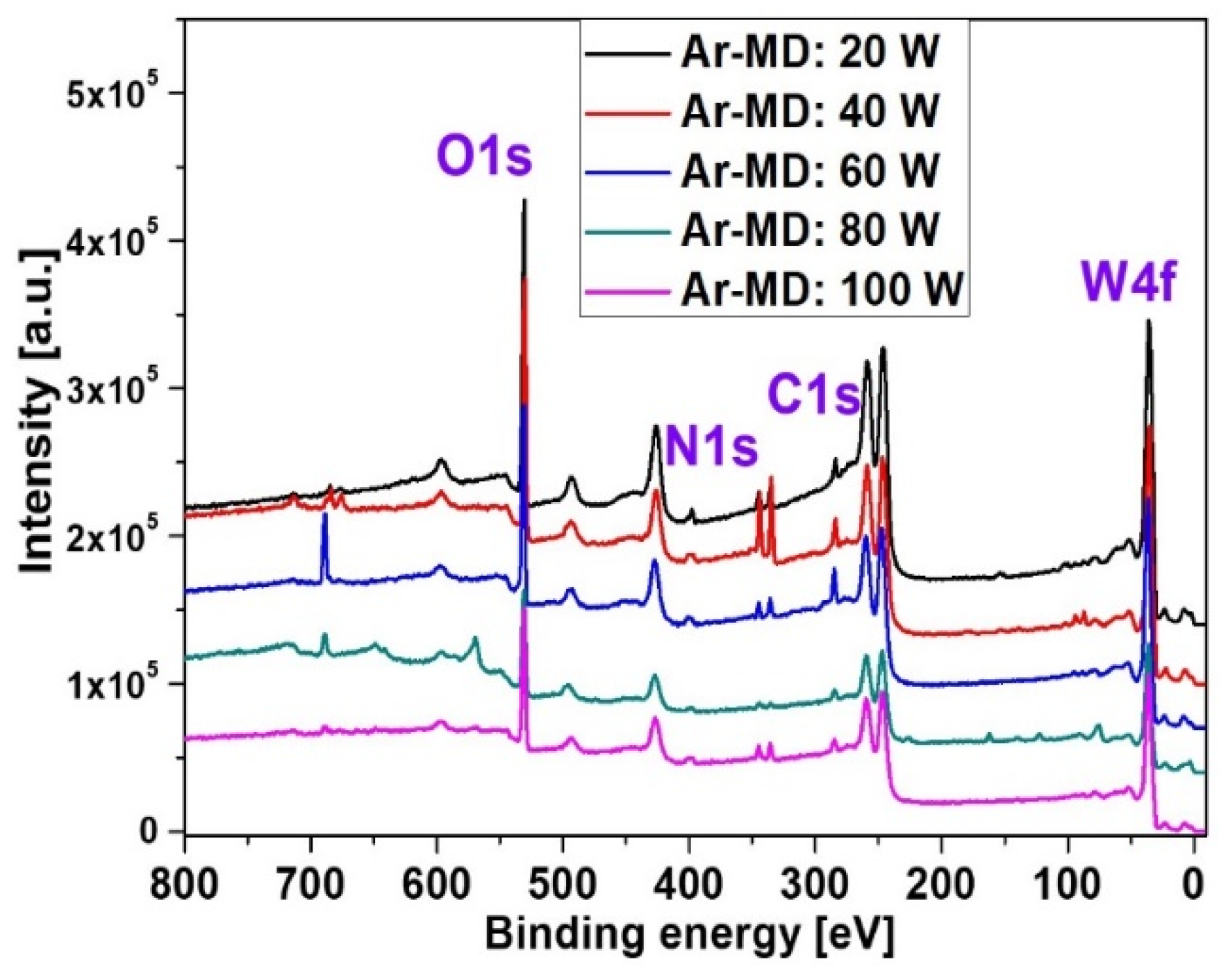
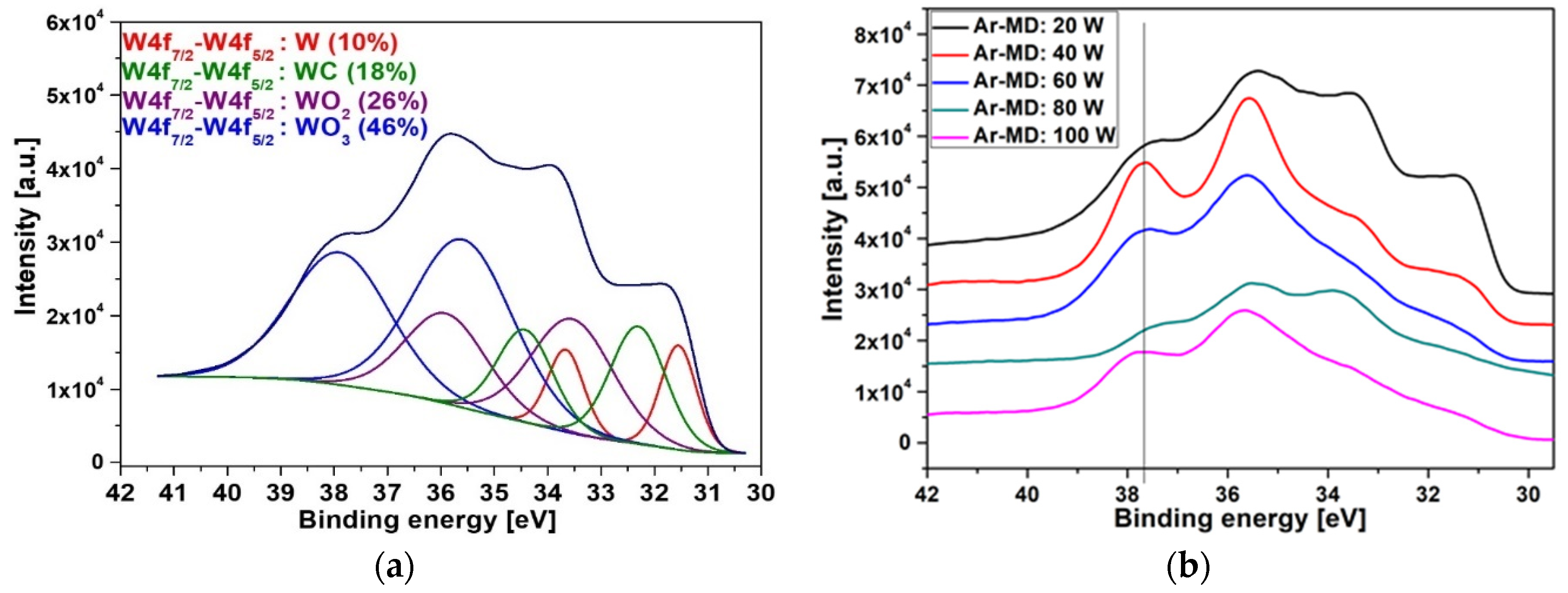
| Distance | At (%) (He-HC) | At (%) (Ar-HC) | ||||||
|---|---|---|---|---|---|---|---|---|
| W4f | C1s | N1s | O1s | W4f | C1s | N1s | O1s | |
| 6 mm | 34.48 ± 0.29 | 15.62 ± 0.64 | 18.75 ± 0.53 | 30.94 ± 0.32 | 42.23 ± 0.24 | / | 7.03 ± 2.13 | 50.74 ± 0.20 |
| 10 mm | 27.35 ± 0.37 | 16.67 ± 0.60 | 9.49 ± 1.58 | 46.48 ± 0.22 | 32.88 ± 0.30 | / | 5.2 ± 2.88 | 61.91 ± 0.16 |
| 20 mm | 12.75 ± 0.78 | 18.45 ± 0.54 | 15.74 ± 0.64 | 53.06 ± 0.19 | 51.60 ± 0.19 | / | 4.62 ± 3.25 | 43.78 ± 0.23 |
| 40 mm | 26.99 ± 0.37 | 30.53 ± 0.33 | 10.36 ± 0.97 | 32.12 ± 0.31 | 61.27 ± 0.16 | / | 6.18 ± 2.43 | 32.55 ± 0.31 |
| Power(RF) | At (%) (Ar-MD) | |||
|---|---|---|---|---|
| W4f | C1s | N1s | O1s | |
| 20 W | 26.86 ± 0.37 | 12.07 ± 0.83 | 6.27 ± 2.39 | 54.8 ± 0.18 |
| 40 W | 20.29 ± 0.49 | 18.99 ± 0.53 | 7.28 ± 2.06 | 53.44 ± 0.19 |
| 60 W | 19.65 ± 0.51 | 26.42 ± 0.38 | 7.45 ± 2.01 | 46.48 ± 0.22 |
| 80 W | 21.13 ± 0.47 | 19.18 ± 0.52 | 6.06 ± 2.48 | 53.63 ± 0.19 |
| 100 W | 21.13 ± 0.47 | 17.32 ± 0.58 | 9.26 ± 1.62 | 52.28 ± 0.19 |
© 2020 by the authors. Licensee MDPI, Basel, Switzerland. This article is an open access article distributed under the terms and conditions of the Creative Commons Attribution (CC BY) license (http://creativecommons.org/licenses/by/4.0/).
Share and Cite
Marascu, V.; Stancu, C.; Satulu, V.; Bonciu, A.; Grisolia, C.; Dinescu, G. Material Erosion and Dust Formation during Tungsten Exposure to Hollow-Cathode and Microjet Discharges. Appl. Sci. 2020, 10, 6870. https://doi.org/10.3390/app10196870
Marascu V, Stancu C, Satulu V, Bonciu A, Grisolia C, Dinescu G. Material Erosion and Dust Formation during Tungsten Exposure to Hollow-Cathode and Microjet Discharges. Applied Sciences. 2020; 10(19):6870. https://doi.org/10.3390/app10196870
Chicago/Turabian StyleMarascu, Valentina, Cristian Stancu, Veronica Satulu, Anca Bonciu, Christian Grisolia, and Gheorghe Dinescu. 2020. "Material Erosion and Dust Formation during Tungsten Exposure to Hollow-Cathode and Microjet Discharges" Applied Sciences 10, no. 19: 6870. https://doi.org/10.3390/app10196870
APA StyleMarascu, V., Stancu, C., Satulu, V., Bonciu, A., Grisolia, C., & Dinescu, G. (2020). Material Erosion and Dust Formation during Tungsten Exposure to Hollow-Cathode and Microjet Discharges. Applied Sciences, 10(19), 6870. https://doi.org/10.3390/app10196870






